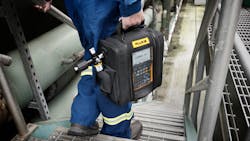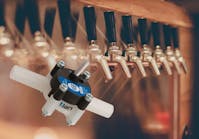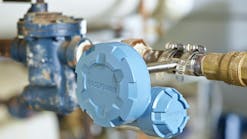Digitizing documentation in calibration to remove human error in highly critical process environments
Calibration, or comparing an instrument to a standard, is a necessary part of keeping your entire facility running smoothly. It enables you to have higher confidence in instruments and tools across the workflow, and regular calibration decreases the risk of issues due to inaccuracies of the process you are working on.
A documenting process calibrator (DPC) can create the calibration procedures or download tasks from calibration management software, such as Fluke's DPCTrack2, and automatically save and store the calibration results for you. These calibration results can then be uploaded to the calibration management software and stored in its database.
Skipping regular calibration can lead to issues with your assets, unplanned costs, unscheduled downtime and even problems with the final products or recalls and rework. Beyond that, some uncalibrated drift can pose hazards to employee safety.
So, it is incredibly important to calibrate instruments at a regular cadence. But how do you keep all of your calibrations organized and on time?
By digitizing the process and using calibration management software as part of your calibration steps.
How does digital documentation make calibration more efficient?
Traditional testing, calibration and documentation processes are incredibly labor-intensive. They usually require someone with historical knowledge and multiple members of a team to complete the process. Even if you have used a pen-and-paper method in the past, that requires the storage space and hoping everything was copied down correctly.
By keeping all calibration information for assets, instruments and tools in one spot, the details are easy to access. As a technician is completing the calibration steps during a routine workflow, the calibration results can be saved and uploaded directly from a DPC to the software you are using. This not only eliminates any possible written errors, but also narrows down the time and effort needed to complete and document the calibration.
Calibration management software can house everything in one place with access to reports, historical records and more. Quick access to this information allows for an enhanced workflow with increased productivity. Less time needs to be spent looking for the historical documents or figuring out what the trend line might look like when a measurement comes back outside of spec. You can instead just pull up the info you have and make the decisions on next steps quickly and easily.
For some calibration management software, documents can be linked to other records within the system with review schedules. Instead of needing to remember when the last calibration was, or when you need to complete the next one, your calibration management software system can do the job for you, reminding you to review or calibrate at a specified frequency.
Following this process allows for reduced operational costs and truly keep regulatory compliance ensured for the work being done in your facility.
Highly critical processes to incorporate calibration management software
While calibration is a critical part of any facility, there is a hierarchy of instruments and assets to prioritize within each industry. Whether that is accuracy in the measurement of substance amounts in a pharmaceutical processing facility or fluid and gas pressure sensors in an oil and gas or chemical processing facility, keeping your process up to compliance regulations, and ensuring your own facility accuracies, is paramount to your work.
Managing the risks around these inaccuracies within a facility is often complicated. Navigating the information requires the proper tools to help technicians avoid costly and unwieldy issues. Putting the inefficient manual process to the side in favor of a digitized calibration process can help keep critical processes running smoothly.
Why calibrate and document?
Calibration is usually a part of the installation process for new devices, or tools, but it is also required when reinstalling or repairing these instruments. Plus, it is a regular occurrence throughout the life of the instruments. These instruments usually require field calibration because they can be located all over the factory floor — on top of cooling towers, connected to pressurized pipes or anywhere process variables like temperature and pressure need to be known to control the process.
Safety
The top reason to conduct regular calibrations is to ensure safety. Not only for your employees, but for the product that is being produced in the facility. Being able to make educated decisions and keep transmitters, switches, valves, gauges and other instruments running as expected to keep everyone safe is the first reason to keep up with regular calibrations.
As you keep up with these calibrations, documenting the findings can help ensure the right decision is being made to keep everyone safe. Getting calibration results from the factory floor to a decision-maker as quickly as possible when something is amiss can always make a difference. And having the calibration history of an instrument can help align those decisions and know what may be causing any issues.
Quality
To perform at the highest efficiency and quality, equipment has to be well maintained and accurate. An instrument showing incorrect readings can reduce the quality of a product, cause rework and ultimately affect the bottom line.
For pharmaceutical facilities and chemical plants, reduced quality anywhere along the process may require an entire batch to be disposed of because a measurement somewhere along the line was a little bit off.
Compliance
Government regulations and enforcement agencies often require calibration and documentation to ensure devices and products conform to the rules and standards they have set forth. Being able to provide this documentation without scrambling to redo a calibration or find the paper notes makes compliance much easier.
When it comes to the food and pharmaceuticals industries, international quality standards (ISO 9001, 9002 and 14001) require that detailed calibration procedures are performed before an audit approval, and ISO 9000 requires calibration of a field instrument be checked at regular intervals. The U.S. Food and Drug Administration (FDA) requires detailed, accurate and up-to-date calibration records.
In an industry such as pharmaceuticals, any changes within the process line — including repair or part replacement, or even a final control element — must be re-validated and traced to documentation before the line can begin work again.
And in most cases, if the calibration and documentation associated with it is not available, it puts the manufacturer at risk of fines by the regulating government agency.
Costs
Both revenue and savings can be affected by calibration and documentation activities. Digital documentation makes many of the measurements needed for tax information much easier to gather. In the oil and gas industry, for example, companies may be required to ensure that the purchased products are measured and taxed correctly. Calibration of the devices that perform custody transfer measurements ensure everyone is paying and receiving the correct amount.
Good calibration practices also lead to savings. Calibration and digital documentation not only lead to higher efficiency throughout a facility, they can also lead to larger savings as the practices are followed regularly. From catching quality issues before an entire batch is lost, or preventing lost revenue due to accidents or issues from inaccurate readings, getting into the habit of conducting calibrations on a regular cadence, and documenting them and having that history easily accessible, can catch all manner of issues before they become too big.
Bob Crepps is a product specialist with Fluke Corporation, focusing on the process calibration tools group. He has more than 30 years of experience providing technical support and training in the electronics industry. Crepps has been offering his expertise to Fluke Process Tools for 10 years.

Bob Crepps | Product specialist with Fluke Corporation
Bob Crepps is a product specialist with Fluke Corporation focusing on the process calibration tools group. With more than 30 years of experience providing technical support and training in the electronics industry, Crepps has been offering his expertise to Fluke Process Tools for 10 years.



